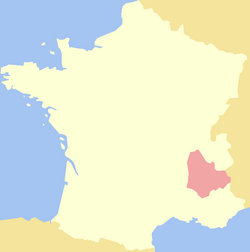Dauphiny
| Dauphiné | |||
|---|---|---|---|
|
|||
 |
|||
| Country | France | ||
| Time zone | CET | ||
The Dauphiné (/ˌdoʊfiːˈneɪ/ or /ˈdoʊfɪneɪ/; French pronunciation: [dofine]) or Dauphiné Viennois, formerly Dauphiny in English, is a former province in southeastern France, whose area roughly corresponded to that of the present departments of Isère, Drôme, and Hautes-Alpes. The Dauphiné was originally the County of Albon.
In the 12th century, the local ruler Count Guigues IV of Albon (c.1095–1142) bore a dolphin on his coat of arms and was nicknamed "le Dauphin" (French for dolphin). His descendants changed their title from Count of Albon to Dauphin of Viennois. The state took the name of Dauphiné. It became a state of the Holy Roman Empire in the 11th century.
The Dauphiné is best known for its transfer from the last non-royal Dauphin (who had great debts and no direct heir) to the King of France in 1349. The terms of the transfer stipulated that the heir apparent of France would henceforth be called "le Dauphin" and included significant autonomy and tax exemption for the Dauphiné region, most of which it retained only until 1457, though it remained an imperial state until the French Revolution.
...
Wikipedia


